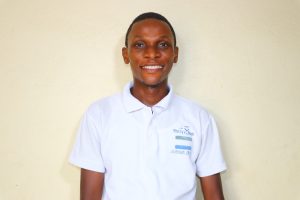In the Tintafor Community, 167 people lack access to safe and sufficient water every single day. The journey to their available waterpoints consumes their time, and the water they manage to collect jeopardizes their health.
None of the sources are safe. A well is the closest option, but it is seasonal. When that isn't an option, they are forced to use surface water. Either source is likely to cause any number of numerous water-related illnesses.
Fourteen-year-old Isatu, like so many children in Sierra Leone, is responsible for collecting water for her family.

Isatu (front) walking to collect water.
"The long walking distance from my house to the waterpoints is one of the greatest challenges I face. This discourages me from fetching water. Especially in the morning hours when I will be busy trying to prepare for school. Another thing that causes delay is the way I fetch water from the open well. There are times [when] the rope that is attached to the rubber [bucket] will cut, and the rubber will fall inside the well. This makes me go to the neighboring houses to either [borrow] a rope, or I switch over to the scoop hole to fetch water. All this makes me not fetch water on time," Isatu shared.
As Isatu shared, not only is their health at risk from the water they collect, but the distance to reach any water is vast. The time she spends walking around to find water is time that could be spent focused on her education or enjoying her childhood, but instead, she sacrifices it all in the name of water.
We asked Isatu how she felt when asked to collect water. She shared, "I normally do not feel good each time my parents send me to fetch water, especially when I am hungry. This is because I will be thinking of the challenges I will face to fetch water from the waterpoints. Being on [an] empty stomach will even make me get less energy to fetch and transport the water. Most times, I will be reluctant to fetch water except my mum gives me words of encouragement. There are times she will even go with me to the waterpoint just to lessen the workload on me. Upon all that, it is still not easy for me."

Isatu collecting water at the unprotected well.
Even with the help of her mother, it's still a heavy burden for Isatu to bear.
"By the time I am through fetching water, it will be difficult for me to go to school on time. I would have already missed both the first and second periods. All this is affecting my performance in terms of exams in school," she added.
Isatu should have the opportunity to attend school consistently, do her homework, and spend time with her friends and family. But none of that is possible in her situation of facing a water crisis.

Isatu carrying water home.
When asked how she would like to spend her time instead of collecting water Isatu said, "I will use that time to visit my friends and even play with them, especially on weekends. All work and no play makes Jack a dull boy."
Playing isn't her only goal. Isatu has big plans for her future!
"I want to be a lawyer in the future. I always have [had] the passion of being a lawyer to help promote justice in my village and the country as a whole," concluded Isatu.
With access to clean, sufficient water, she can achieve those dreams. Rehabilitating her community's well is the first step in the right direction. Isatu will have the tools to create a life for herself, unencumbered by the water crisis.
Steps Toward a Solution
Our technical experts worked with the local community to identify the most effective solution to their water crisis. They decided to drill a borehole well, construct a platform for the well, and attach a hand pump.
Well
Abundant water often lies just beneath our feet. Aquifers—natural underground rivers—flow through layers of sediment and rock, offering a constant supply of safe water. A borehole well is drilled deep into the earth to access this naturally filtered and protected water. We penetrate meters, sometimes even hundreds of meters, of soil, silt, rock, and more to reach the water underground. Once found, we construct a platform for the well and attach a hand pump. The community gains a safe, enclosed water source capable of providing approximately five gallons of water per minute. Learn more here!
Community Education & Ownership
Hygiene and sanitation training are integral to our water projects. Training is tailored to each community's specific needs and includes key topics such as proper water handling, improved hygiene practices, disease transmission prevention, and care of the new water point. Safe water and improved hygiene habits foster a healthier future for everyone in the community. Encouraged and supported by the guidance of our team, a water user committee representative of the community's diverse members assumes responsibility for maintaining the water point, often gathering fees to ensure its upkeep.

 Borehole Well and Hand Pump
Borehole Well and Hand Pump

















